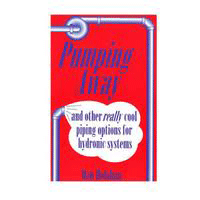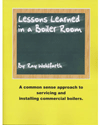Loyalty is never lost: What is your value add for the customer?

Way back in 2003, I was headed to ISH (International Sanitary, Heating and Air-conditioning Technology) with the NAOHSM (National Association of Oil Heat Service Managers) group headed, at that time, by Judy Garber. Dan Holohan, along with Garber, was our group leader. Before we would attend ISH and wear out our shoes walking the miles of halls, we visited the Viessmann School of Technology and toured the factory. The factory tour was impressive, but the school even more so with its hands-on lab featuring the wide array of Viessmann products. In Europe, technicians were required to attend the school and live in what we would consider rather austere living quarters where we spent the night. The dining hall did have beer, however, so not all was lost!
We also toured the parts warehouse, which is where their wholesale operation came into focus. In European countries, contractors often deal directly with manufacturers and at ISH, we would frequently see contractors meeting with manufacturers’ booth personnel to hash out pricing for their future purchases. This warehouse was where the rubber met the road. There was just one “counter person” picking and shipping orders! The warehouse was massive and we could view the scene unfolding before our eyes from a balcony position with a glass wall exposing the aisles of merchandise stacked a mile high on racks in neatly organized pallets.
As each order arrived via a computer terminal, the counter person would review it and then forward it to the warehouse “pickers”. The pickers were robots! Each one knew exactly where the pallet was located for the part needed and would take off to retrieve that pallet and whisk it off to the counter person via a conveyor belt. The counter person would pick the part and scan its label before placing it in that customer’s assigned shipping container. The parts pallet was then sent back to the warehouse via the conveyor belt that looped back where any one of the robots would grab it and return it to a shelf. As was explained, to us, any opening on the miles of aisles was acceptable for any parts pallet because each pallet was identified, labeled, and logged into memory so that every robot knew exactly where it was within the huge warehouse.
Here, on our side of the pond, we do things differently, right? From this contractor’s perspective, your counter people made a huge difference in where I went for parts and products. When one of my favorite supply houses was sold, the new owner had no clue about the difference in O.D. or I. D. or, for that matter, how to read a tee. You might ask for a 1 x ¾ x ½ tee (along with dozens of other items) only to find, once back on the job site, it was a 1 x ½ x ¾ tee! Eventually most of the customer base went elsewhere and the business went bankrupt. Great counter people are one of your most valuable assets. Unlike the impersonal never-seen-in-person counter person at the Viessmann warehouse in Germany, we value our personal face-to-face relationships at your supply house counters.
Today, of course, and in no small part due to the pandemic, we have steered away from personal face-to-face meetings and it’s more likely we will utilize your online site to pick materials and quantities that will either be delivered to our shop, or job site, or that we’ll dash-and-grab on our way to a job site. Your margins have been squeezed (more like choked to death) by competition utilizing the Internet with aggressive pricing because they often do not have brick-and-mortar infrastructure and, if the dollar amount is large enough, offer free shipping. So long as you stock the goods, you have the advantage of faster procurement by your customers. Our personal relationships lead to friendships and most people tend to do business with people they like and trust.
Price vs. value was always a key in every customer relationship I had during my 48-year career. Once I established trust, and folks knew I had their best interest at heart, price became secondary. The only time price became of paramount importance before a supply house order was given was when competitive bidding forced my hand. Otherwise, I did not haggle or strive to beat-down quotes provided because it was my job to sell our work to customers and do so at a reasonable profit. I wanted my wholesalers to make money too because I needed them to thrive while providing exceptional service both before and after the sale.
When I ventured out on my own in 1979, it was spurred on by a lucky break. A friend of the family was aware I was thinking about taking the leap and asked me to meet him in his office on a Saturday morning. He had a very successful commercial flooring business and he was planning on building a large custom five-bath home. He asked me to look over the blueprints and then asked me how much the plumbing and HVAC would cost. I’d never bid anything, especially a project of that magnitude! He pressed for an answer, said just to ballpark the number. “Give it a SWAG” he said! I threw out what I thought was a high number and he turned around to do something. When he swung back around, he handed me a check for the full amount and said, with a twinkle in his eye, “So, when exactly did you say you were going into business?”
For my part, I very carefully did a thorough takeoff for the plumbing, heating, and air conditioning while listing every single part right down to the associated hardware. Probably 20-pages long! One eager supply house salesman had been telling me to call him once I ventured bout on my own. He had been our family plumber, so I knew him from those visits. “I’ll treat you right.” I provided my 20-page list to several supply houses with my stated intention of not haggling, so give me the best price from the start. His price far exceeded the other supply house quotes – by a huge margin. The other quotes were all relatively close to each other. When I told him he was high, he wanted to know by how much and when I gave him the dollar figure, he demanded to see the other supply house quotes. I wanted to treat every supply house quote with confidentiality because I had worked for a mechanical contractor who played the game of beating down pricing by revealing other supply house quotes and round-and-round he’d go. I didn’t cherry-pick the supply house quotes either, but gave the complete order to one only.
Loyalty is a rare commodity these days, more so than it was back in 79, but it does exist if nurtured properly. Where does your value-added service excel? Why would contractors patronize your supply house instead of a big box store or Internet “store”? How easy is your online catalog to browse and use to pick orders? Are your people user friendly and knowledgeable regarding the products you sell? I’ll posit this proposition: if you focus on these issues, along with internal reviews and guidelines to gage performance, you will be in a great position to excel in your marketplace.
Looking for a reprint of this article?
From high-res PDFs to custom plaques, order your copy today!










